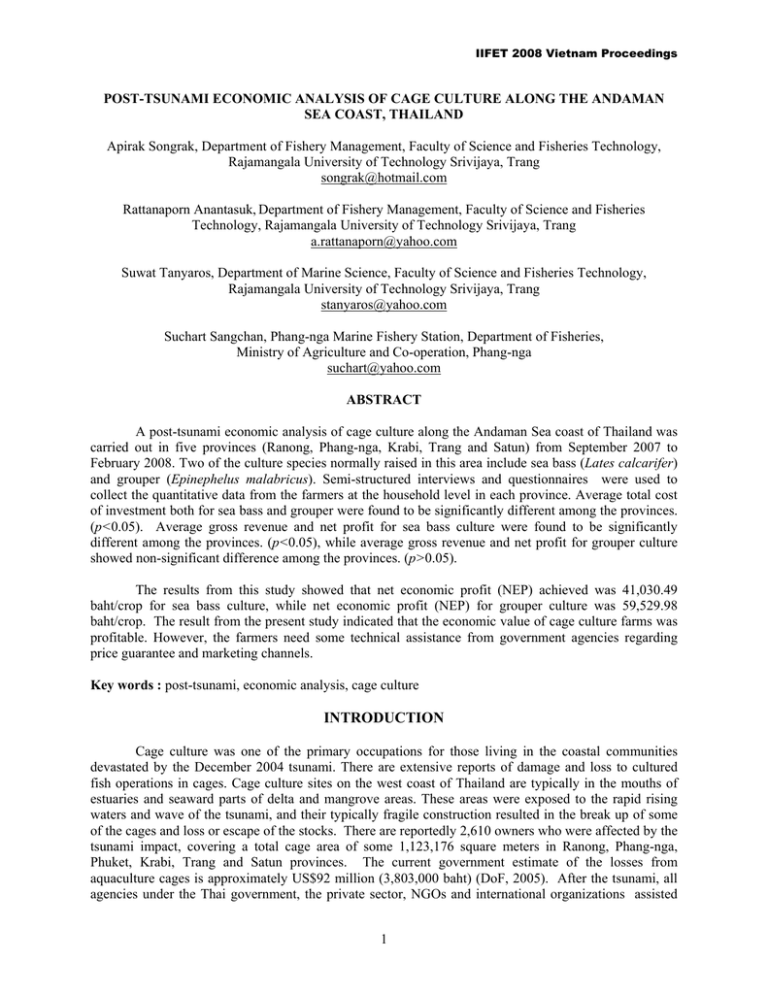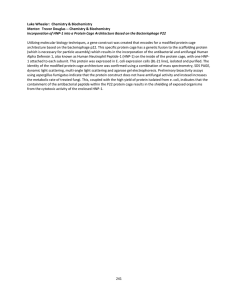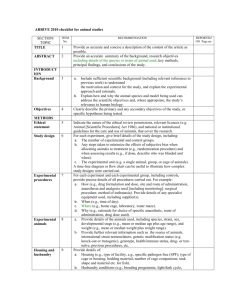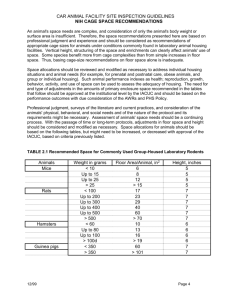Rajamangala University of Technology Srivijaya, Trang Rattanaporn Anantasuk,
advertisement

IIFET 2008 Vietnam Proceedings POST-TSUNAMI ECONOMIC ANALYSIS OF CAGE CULTURE ALONG THE ANDAMAN SEA COAST, THAILAND Apirak Songrak, Department of Fishery Management, Faculty of Science and Fisheries Technology, Rajamangala University of Technology Srivijaya, Trang songrak@hotmail.com Rattanaporn Anantasuk, Department of Fishery Management, Faculty of Science and Fisheries Technology, Rajamangala University of Technology Srivijaya, Trang a.rattanaporn@yahoo.com Suwat Tanyaros, Department of Marine Science, Faculty of Science and Fisheries Technology, Rajamangala University of Technology Srivijaya, Trang stanyaros@yahoo.com Suchart Sangchan, Phang-nga Marine Fishery Station, Department of Fisheries, Ministry of Agriculture and Co-operation, Phang-nga suchart@yahoo.com ABSTRACT A post-tsunami economic analysis of cage culture along the Andaman Sea coast of Thailand was carried out in five provinces (Ranong, Phang-nga, Krabi, Trang and Satun) from September 2007 to February 2008. Two of the culture species normally raised in this area include sea bass (Lates calcarifer) and grouper (Epinephelus malabricus). Semi-structured interviews and questionnaires were used to collect the quantitative data from the farmers at the household level in each province. Average total cost of investment both for sea bass and grouper were found to be significantly different among the provinces. (p<0.05). Average gross revenue and net profit for sea bass culture were found to be significantly different among the provinces. (p<0.05), while average gross revenue and net profit for grouper culture showed non-significant difference among the provinces. (p>0.05). The results from this study showed that net economic profit (NEP) achieved was 41,030.49 baht/crop for sea bass culture, while net economic profit (NEP) for grouper culture was 59,529.98 baht/crop. The result from the present study indicated that the economic value of cage culture farms was profitable. However, the farmers need some technical assistance from government agencies regarding price guarantee and marketing channels. Key words : post-tsunami, economic analysis, cage culture INTRODUCTION Cage culture was one of the primary occupations for those living in the coastal communities devastated by the December 2004 tsunami. There are extensive reports of damage and loss to cultured fish operations in cages. Cage culture sites on the west coast of Thailand are typically in the mouths of estuaries and seaward parts of delta and mangrove areas. These areas were exposed to the rapid rising waters and wave of the tsunami, and their typically fragile construction resulted in the break up of some of the cages and loss or escape of the stocks. There are reportedly 2,610 owners who were affected by the tsunami impact, covering a total cage area of some 1,123,176 square meters in Ranong, Phang-nga, Phuket, Krabi, Trang and Satun provinces. The current government estimate of the losses from aquaculture cages is approximately US$92 million (3,803,000 baht) (DoF, 2005). After the tsunami, all agencies under the Thai government, the private sector, NGOs and international organizations assisted 1 IIFET 2008 Vietnam Proceedings tsunami victims and improved the cage farmer’s livelihood (Office of Natural Resources and Environment Policy and Planning, 2006). This paper aims to study the post-tsunami economy of cage culture farms as a consequence of strong efforts by agencies in providing help, rehabilitation, restoration and development. The result in the present study can indicate the potential of assistance from those agencies for cage farms and can shed light on what is needed in futurefor success in such an effort. METHODOLOGY Study Area The sites area for the study on the economy of cage culture farms located in five provinces including Ranong, Phang-nga, Krabi, Trang and Satun provinces along the coast of the Andaman Sea, southern Thailand (Figure 1). The cage farms in 9 communities from 5 provinces were selected for gathering the cage farm economic data. The names of study sites and number of farms in each province are summarized in Table 1. Figure 1 The location of the study sites Table 1. The study sites and number of farms in each province. Province Ranong Phang-nga Krabi Trang Satun Study sites Ban Klong Naka, Sooksamran District Ban Kura, Kuraburi District Ban Thung Ma Phow, Tai-muang District Ban Num-Khem, Taguapa District Ban Ba Gan, Ao-Luek District Ban Tha-Ma Phow, Klong-Thom District Ban Prujood, Sikao District Ban Ton Harn, Palian District Ban Ba Kan-Kai, Mouang District 2 Number of farms 30 40 60 52 60 12 15 40 40 IIFET 2008 Vietnam Proceedings Collecting of Farm Economic Data Semi-structured interviews and questionnaire were developed to collect the quantitative data from the farmers at the household level in each of the cage culture areas. The data collection was conducted between September 2007 – February 2008. Information was gathered via a survey regarding the cost of investment, production, and income in each farm. The data pertaining to grouper and sea bass in this study were separately collected. The data collected from each culture species were analyzed for the fixed cost, variable cost, total cost, income and profit. The farm revenue (per 4 cages) was analyzed by the economic analysis method of Phetrat (1992) as follows: Gross Economic Profit (GEP) = Total Farm Cash Receipts (TR) – Total Variable Costs (TVC) Net Economic Profit (GNP) = Total Farm Cash Receipts (TR) – [Total Variable Costs (TVC)+ Total Fixed Costs (TFC)] Statistical Analysis One-way ANOVAs was applied to compare the mean of cost and revenue of cage culture among the provinces. If significant effects were present, the data was then subjected to Duncan’s Multiple Range Test (DMRT) to check at confident level of 95% by using the package software SPSS for Windows version 11.0 (Srisakulthew, 2001). RESULTS AND DISCUSSION Grouper (Epinephelus malabricus) and sea bass (Lates calcarifer) were the main culture species found in 5 provinces in cage farms on the Andaman Sea coast of Thailand. Most cage farm activities were operated as small businesses or “family businesses”. The typical cage farm was operated at limited cost and requires household labor. Seed stock can be obtained by fishing or can be purchased. The current seed supply is problematic because the trend of seed catching in the wild has been gradually reduced over recent years. Trash fish from the fishing operation were used as the feed source, although in times of low catch, trash fish may be purchased for use as feed. Analyzing the Economy of Sea Bass Cage Culture The economy of sea bass cage culture in the present study was specifically selected for four cages/farm with a cage size 3 x 3 x 2 m. (width x length x depth). The highest total cost of investment was in Phang-ang province, equal to 78,340.00 baht/farm, while the total cost of investment in the remaining provinces was as follows: 75,140.00, 59,348.67, 55,715.15 and 43,982.33 baht/farm in Ranong, Satun, Trang and Krabi, respectively. Statistical analysis on the average total cost of investment was found to be significantly different among the provinces. (p<0.05) (Figure 2). Ranong province had the highest gross revenue (104,500.00 baht/farm), while the lowest gross revenue was found in Krabi province (46,964.33 baht/farm). Statistical analysis on the average gross revenue was significantly different among the provinces. (p<0.05) (Figure 3). The highest net profit for sea bass cage culture in the present study was in Trang province (29,931.52 baht/farm), while the lowest net profit was in Krabi province (2,982.00 baht/farm). Statistical analysis on the net profit was significantly different among the provinces (p<0.05) (Figure 4). 3 IIFET 2008 Vietnam Proceedings Figure 2 The averages of total cost of sea bass cage culture. Figure 3 The averages of gross revenue of sea bass cage culture. 4 IIFET 2008 Vietnam Proceedings Figure 4 The averages of net profit of sea bass cage culture. Analyzing the Economy of Grouper Cage Culture The economy of grouper cage culture in the present study was selected as being similar to sea bass cage culture. Statistical analysis of the average total cost of investment was significantly different among the provinces. (p<0.05) (Figure 5). The highest total cost of investment was in Satun province, 95,216.67 baht/farm, while the lowest total cost investment was in Krabi province (59,558.33 baht/farm). Ranong province had the highest gross revenue (196,000.00 baht/farm), while the lowest gross revenue was in Krabi province (123,345.30 baht/farm). However, statistical analysis findings on the average gross revenue were non-significant among the provinces. (p>0.05) (Figure 6). The highest net profit in the present study was in Ranong province (111,185.00 baht/farm), while the lowest net profit was in Krabi province (63,787.00 baht/farm). Statistical analysis of the net profit differences was non-significant among the provinces (p>0.05) (Figure 7). 5 IIFET 2008 Vietnam Proceedings Figure 5 The averages of total cost of grouper cage culture. Figure 6 The averages of gross revenue of grouper cage culture. 6 IIFET 2008 Vietnam Proceedings Figure 7 The averages of net profit of grouper cage culture Farm Economic Assessment In general, the economic potential of sea bass cage culture was regulated by the price of seed and feed, stocking density, culture period and feed conversion ratio (FCR). In the present study, the hatchery seed of sea bass of the size 4-5 inches was usually stocked in cages (3 x 3 x 2 m.). The fish were raised 400 fries/cage. The fish reached marketable size within 8 months. The average survival rate of 70% was obtained with an average feed conversion ratio (FCR) of 4.85. The average price of the product was 115 baht/kg. The average total cost of 62,009.51 baht/crop was attained, including 6.56% of fixed cost 6.56 % and 93.44% of variable cost (Figure 8). Cost of feed is the single most expensive item in the cost of production, comprising 48.96% of total cost, while the cost of seed comprised 25.80% of the total cost. Gross revenue of 103,040.00 baht was obtained per crop. The net economic profit (NEP) of 41,030.49 baht was achieved per crop as summarized in Table 2. The result from the present study is similar to the economic analysis of sea bass cage culture reported by DoF (2004). For grouper cage culture, the rate of stocking density and size of the seed were similar to sea bass culture. The fish were raised with 400 fries/cage. The time of culture was 12 months/crop. The average survival rates were 60 % with the feed conversion ratio (FCR) of 5.45. The price of grouper at marketable size (0.8-1 kg) was higher than sea bass. The average price of the product was 220 baht/kg. The average total cost was 151,670.02 baht/crop, which included 3.52 % of fixed cost and 96.48% of variable cost (Figure 9). The current seed supply is problematic because the trend of seed catching in the wild has been gradually reduced over recent years. However, current grouper cage culture is still based on the supply of wild grouper seed. To meet the demand, alternative sources of supply had to be found from other provinces and the seed availability determined. As a consequence, the price of grouper seed increased 3-4 fold over the last few years. Therefore, the total cost of seed comprised 42.20 %, while the total cost of feed accounted for 40.82 %. The gross revenue of 211,200.00 baht was obtained per crop. The net economic profit (NEP) of 59,529.98 baht per crop is summarized in Table 3. The result from the present study is similar to the economic analysis of grouper cage culture reported by Laohakul (2000) and SEAFDEC (2008). 7 IIFET 2008 Vietnam Proceedings The average total cost per crop of sea bass culture was lower than grouper culture as a result of the times of culture per crop, times of feed per day, the cost of seed and chemical used. The net economic profit of grouper was higher than sea bass due to the higher market price. Figure 8 The cost of sea bass cage culture farm. Figure 9 The cost of grouper cage culture farm. 8 IIFET 2008 Vietnam Proceedings Table 2. The economic analysis of sea bass cage culture (4 cages/farm; cage size 3 x 3 x 2 m.) Unit : Baht/farm/crop 1 US$ = 32 baht Item Cash cost 1. Fixed cost - Depreciation of cages - Constant opportunity fixed cost ( loan 1.75% / year) 2. Variable cost - Seed - Feed - Assessment of labor - Fuel, oil and chemical - Constant opportunity variable cost ( loan 1.75% / year) 1. 2. 3. 4. 5. 6. Total cost Percent (%) 0.00 0.00 0.00 4,066.17 3,928.67 137.50 4,066.17 3,928.67 137.50 6.56 6.34 0.22 47,166.67 16,000.00 21,566.67 0.00 9,600.00 0.00 10,776.27 0.00 8,626.40 1,600.00 0.00 550.27 57,943.34 16,000.00 30,193.07 1,600.00 9,600.00 550.27 93.44 25.80 48.69 2.58 15.48 0.89 14,842.44 62,009.51 69.21 100.00 3. Total cost - Baht/farm 47,166.67 - Baht/kg. Cage size 3. x 3 x 2 m. = 18.0 m3 (cost 4,250 Baht/cage) Survival rate (%) 70 Times of culture/crop (month) 8 Average harvest/cage (kg.) 224.00 Average harvest/farm (kg.) 896.00 Gross revenue (baht/farm/crop) 103,040.00 Gross economic profit(baht/farm/crop) 55,873.33 Net economic profit (baht/farm/crop) 41,030.49 Remarks: Non-cash cost Stocking rates for cage = 400 fries/cage Size of seed , average of total length = 4-5 inch. Price of seed = 10 baht/fry Feed conversion ratio (FCR) = 4.85 : 1 Size of harvest = 0.8 kg./body Price of harvest = 115 baht/kg. 9 IIFET 2008 Vietnam Proceedings Table 3. The economic analysis of grouper cage culture (4 cages/farm; cage size 3 x 3 x 2 m.) Unit : Baht/farm/crop 1 US$ = 32 baht Items Cash cost 1. Fixed cost - Depreciation of cages - Constant opportunity fixed cost ( loan 1.75% / year) 2. Variable cost - Seed - Feed - Assessment of labor - Fuel, oil and chemical - Constant opportunity variable cost (loan 1.75% / year) 1. 2. 3. 4. 5. 6. Total cost Percent (%) 0.00 0.00 0.00 5,341.17 5,249.31 91.86 5,341.17 5,249.31 91.86 3.52 3.46 0.06 124,620.00 64,000.00 44,200.00 0.00 16,400.00 0.00 21,708.85 0.00 17,688.00 2,400.00 0.00 1,620.85 146,328.85 64,000.00 61,908.00 2,400.00 16,400.00 1,620.85 96.48 42.20 40.82 1.58 10.81 1.07 27,050.02 151,670.02 157.99 100.00 3. Total cost - Baht/farm 124,620.00 - Baht/kg. Cage size 3 x 3 x 2 m. = 18.0 m3 (cost 4,250 baht/cage) Survival rate (%) 60 Times of culture/crop (month) 12 Average harvest/cage (kg.) 240.00 Average harvest/farm(kg.) 960.00 Gross revenue (baht/farm/crop) 211,200.00 Gross economic profit(baht/farm/crop) 86,580.00 Net economic profit (baht/farm/crop) 59,529.98 Remarks : Non-cash cost Stocking rates for cage = 400 fries/cage Size of seed , average of total length = 4-5 inch. Price of seed = 40 baht/fry Feed conversion ratio (FCR) = 5.45 : 1 Size of harvest = 1.0 kg./body Price of harvest = 220 baht/kg. 10 IIFET 2008 Vietnam Proceedings ACKNOWLEDGMENTS I am very grateful to the Faculty of Science and Fisheries Technology, Rajamangala University of Technology Srivijaya, for funding and laboratory support. We thank Ms.Ratanaporn Rhittripat for assistance in data collection. We also wish to thank Bill Templer for assistance in editing the manuscript. REFERENCES DoF. 2004. Sea food bank project. Unit of Fisheries Economic, Department of Fisheries, Ministry of Agriculture and Co-operation, Bangkok. DoF. 2005. The compensation package for cage farms (Accessed 10 June 2007) Available from http://www.cffp.th.com/tsunami. Laohakul, P. 2000. An economic analysis of grouper (epinephelus tauvina) cage culture in Changwat Phang-nga, southern Thailand. Department of Agribusiness, Faculty of Agriculture, Prince of Songkhla University, Songkla province, Thailand Office of Natural Resources and Environment Policy and Planning. 2006. 2 Years after Tsunami Restoration of Thailand’s Natural Resources and Environment. Ministry of Natural Resources and Environment, Bangkok, Thailand. 150 pp. Phetrat, J. 1992. Principles of management and farm business administration. Department of Agriculture Development, Faculty of Natural Resources, Prince of Songkhla University, Thailand. 367 pp. Srisakulthew, P. 2001. Principles of Aquatic Farm Management. Department of Fisheries, Faculty of Agriculture, Khon Kaen University, Thailand. pp. 139-153. SEAFDEC. 2008. Marine cage culture of grouper technology description. SEAFDEC Aquaculture Department. (Accessed 23 February 2008) Available from http://www.aqd.seafdec.org/marinecage culture of grouper. 11



